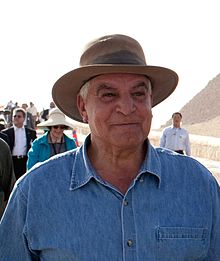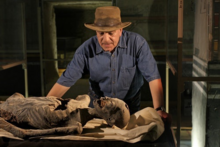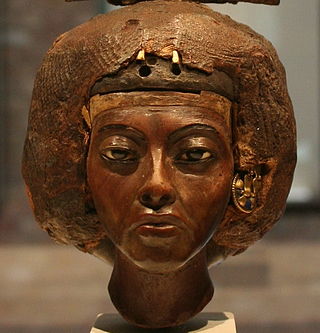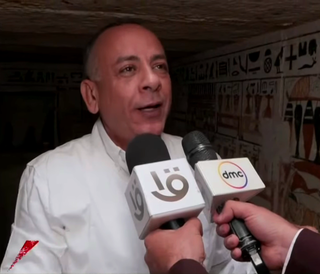Zahi Hawass | |
|---|---|
| زاهي حواس | |
 | |
| 1st Minister of Antiquities |
This section of a biography of a living person needs additional citations for verification .(January 2016) |
Archaeology and early government career
Hawass was Associate Director of Excavation at Hermopolis in 1968 and Tarrana 1970–74. Since 1975, he has been Excavation Director and Restoration Director at various sites throughout Egypt, predominantly Giza. [5]
From 1969 to 1975, Hawass was Inspector of Antiquities for a multitude of archaeological expeditions, for instance the Yale Expedition at Abydos, Egypt in 1969, and Abu Simbel between 1972 and 1974. [6]
He sporadically taught Egyptian archaeology and history and culture at universities in Egypt and the USA between 1988 and 2001, most notably at the American University in Cairo, the University of California, Los Angeles and Alexandria University. Hawass has described his efforts as trying to help institute a systematic program for the preservation and restoration of historical monuments, while training Egyptians to improve their expertise on methods of excavation, retrieval and preservation. [7]
Giza

Hawass was Inspector of Antiquities for Giza 1972–74, First Inspector until 1979 and Chief Inspector in 1980. Starting in 1987, he held the position of Director General of the Giza monuments, which included the sites of Giza, Saqqara, Memphis, Dahshur, Abusir and Bahariya Oasis.
After the discovery of Gantenbrink's Door in 1993, he left the position – according to Hawass, a resignation [8] – but was reinstated several months later, following a change in leadership and the transformation of the Egyptian Antiquities Organization into the Supreme Council of Antiquities.
He was promoted to Undersecretary of the State for the Giza Monuments in 1998. [9]
Hawass continues to be involved in archaeological projects at Giza and other sites in Egypt. As of 2017 [update] , he headed the science committee overseeing the ScanPyramids project. [10]
Politics
In 2002, Hawass was appointed as the Secretary General of the Supreme Council of Antiquities. When US President Barack Obama visited Cairo in June 2009, Hawass gave him personal tours of ancient Egyptian archaeological sites. [11] Facing mandatory retirement, he was promoted by President Hosni Mubarak to the post of Vice Minister of Culture at the end of 2009. [12] [13]
2011 protest vandalism
On January 29, 2011, in the midst of the Egyptian protests of that year, Hawass arrived at the Egyptian Museum in Cairo to find that a number of cases had been broken into and a number of antiquities damaged, so police were brought in to secure the museum. [14] According to Andrew Lawler, reporting for Science, Hawass said that he "faxed a colleague in Italy that 13 cases were destroyed. My heart is broken and my blood is boiling". [15]
Hawass later told The New York Times that thieves looking for gold broke 70 objects, including two sculptures of the pharaoh Tutankhamun and took two skulls from a research lab, before being stopped as they left the museum. [16]
Minister of Antiquities
Hawass was appointed to the position of Minister of State for Antiquities Affairs, a newly created cabinet post, by Mubarak on January 31, 2011, as part of a cabinet shake-up during the 2011 protests. [15] [16] [17] [ dead link ] A press release including a statement from Hawass stated that he "will continue excavating, writing books, and representing his country," [18] ensuring that archaeological sites in Egypt were being safeguarded and looted objects returned.[ citation needed ] Regarding the Egyptian Museum looting, he said: "The museum was dark and the nine robbers did not recognise the value of what was in the vitrines. They opened thirteen cases, threw the seventy objects on the ground and broke them, including one Tutankhamun case, from which they broke the statue of the king on a panther. However, the broken objects can all be restored, and we will begin the restoration process this week."[ This quote needs a citation ] [17] Hawass rejected comparisons with the looting of antiquities in Iraq and Afghanistan. [16]
On February 13, Mahmoud Kassem of Bloomberg reported Hawass as saying that "18 artifacts, including statues of King Tutankhamun", were stolen from the Egyptian Museum in January; Kassem, paraphrasing Hawass, continues: "The missing objects include 11 wooden shabti statuettes from Yuya, a gilded wooden statue of Tutankhamun carried by a goddess and a statue of Nefertiti making offerings". [19]
Egyptian state television reported that Hawass called upon Egyptians not to believe the “lies and fabrications” of the Al Jazeera and Al Arabiya satellite television channels. [20] Hawass later said: “They should give us the opportunity to change things, and if nothing happens they can march again. But you can’t bring in a new president now, in this time. We need Mubarak to stay and make the transition”. [16] On March 3, 2011, he resigned after a list was posted on his personal website of dozens of sites across Egypt that were looted during the 2011 protests. [21] [22] [23] [24] [25]
Hawass was reappointed Minister of Antiquities by then-Prime Minister Essam Sharaf. [26] [27] On March 30, 2011, a tweet was posted, stating: "I am very happy to be the Minister of Antiquities once again!" [28] but resigned on July 17, 2011,[ citation needed ] after Sharaf informed him he would not be continuing in the position. [29] According to opinion report from an Egyptian commentator in The Guardian, Hawass was "sacked". [30] [ dubious – discuss ][ better source needed ]
Claimed discoveries

As his biography at the National Geographic Explorers webpage notes, he states that he is
responsible for many recent discoveries, including the tombs of the pyramid builders at Giza and the Valley of the Golden Mummies at Bahariya. At Giza, he also uncovered the satellite pyramid of Khufu. In 2005, as part of the National Geographic Society-sponsored Egyptian Mummy Project to learn more about patterns of disease, health, and mortality in ancient Egypt, he led a team that CT scanned the mummy of King Tutankhamun. His team is continuing to CT scan mummies, both royal and private, and hopes to solve some of the mysteries surrounding the lives and deaths of such important figures as Hatshepsut and Nefertiti. [31]

















